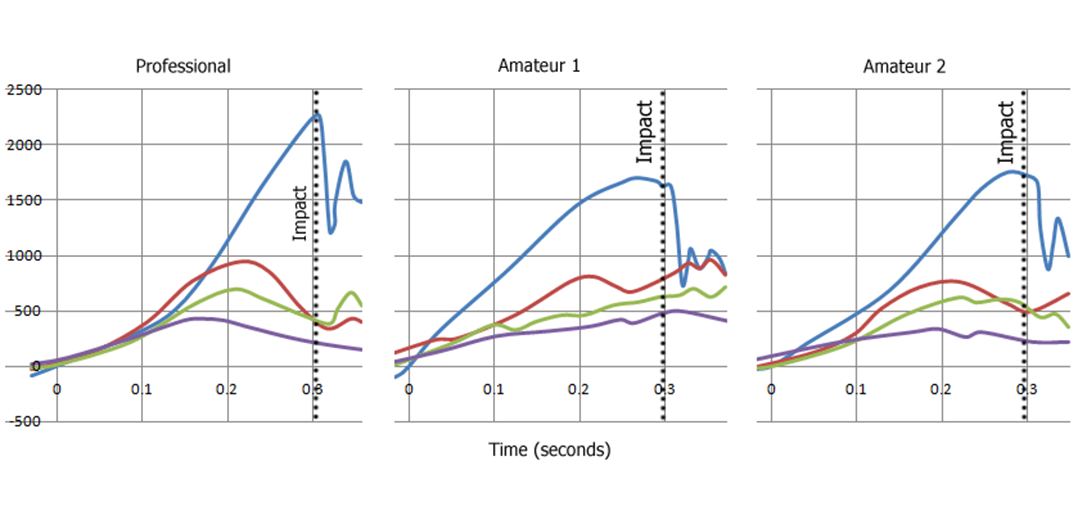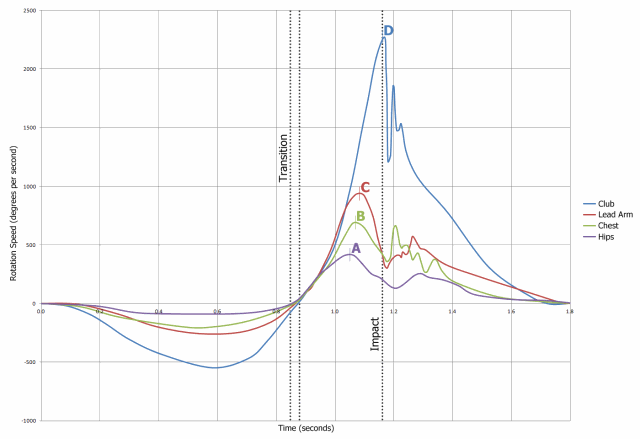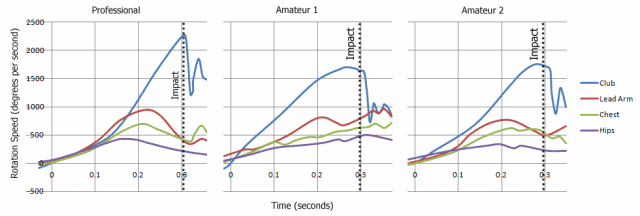It’s a statement of the obvious, but the vast majority of amateur golfers don’t swing as effectively as Tour professionals. They don’t hit the ball as accurately, as consistently, or as far.
In this article, we’ll compare the kinematic sequence of a typical Tour professional’s golf swing with that of a number of amateur swings. We will examine the key differences between the swing sequences and timing.
If you’re not an elite golfer, your swing will have some of the faults described here. A better understanding of what those faults are, and why they hurt your swing, will help you to understand what constitutes a great golf swing, the underlying cause of your inefficiencies, and how you can improve.
Much of this article is discussed in the context of what elite golfers do in their swings. But what any given golfer does is not necessarily biomechanically perfect, so we choose real-life examples, and what can be learned from them, very carefully.
Unlike other golf tuition, the instruction presented in the Swing like a Champion system is based strictly on what is biomechanically correct, and not just on what works for other people.
The knowledge presented here, together with the Swing like a Champion system, will help you to quickly build a great golf swing.
Professional versus Amateur Golf Swing
Let’s take another look at the Tour professional’s golf swing kinematic sequence from Golf Swing Sequence and Timing.
Figure 1. Tour Professional Golf Swing Kinematic Sequence
The graph in Figure 1 progresses in time from left to right. Negative rotational speeds indicate movement away from the target in the backswing. Positive rotational speeds indicate movement toward the target in the downswing.
The graph shows the rotational speeds of the hips (pelvis), chest (thorax), lead arm, and the golf club during a typical professional golf swing.
We can see clearly that the swing has relatively smooth accelerations and decelerations until after impact. As we discussed in Golf Swing Sequence and Timing, the swing has a very efficient sequence of motion in the downswing. Each segment reaches speeds that are faster than the previous segment, and then decelerates rapidly as energy is transferred outwards, with each segment peaking fractionally later that the previous one. The hips peak first (A), then the chest (B), then the arms (C), and finally the club (D) at impact.
The fact that the downswing curves are so uncomplicated (a simple, smooth, up and then down) means that the professional can be very consistent.
Notice also that club speed peaks just after impact, it is still accelerating when it hits the ball.
Amateur Golfer’s Kinematic Sequence
Now let’s examine the golf swing of a typical amateur golfer.
Figure 2. Amateur Golfer’s Kinematic Sequence
There are some immediately obvious differences in the amateur swing:
- Every segment has lower speeds in the downswing, especially the golf club.
- The club reaches peak speed just before impact, so it is decelerating through impact, and thus the club head is less stable.
- The transition phase is very short — in fact the typical amateur golfer changes direction, at the top of the backswing, 3 times more quickly than a professional. You can see a detailed analysis of the kinematic sequence of the Transition phase in Golf Swing Sequence and Timing – The Transition.
- Immediately after the transition, the club (blue) is rotating faster than the lead arm (red), and so the wrist angle is opening, indicating casting — the golfer is not generating lag in the golf club.
- The accelerations and decelerations are not smooth in the downswing, the hips even have a “double peak” of rotational velocity before impact, indicating a lack of stability and control. This complexity makes it impossible for the amateur to be consistent.
- The peak speeds of each segment are out of sequence, with the arm (C) peaking before the chest (B). This prevents an efficient transfer of energy along the kinetic chain.
- The accelerations of each segment are not evenly spaced, and the peak speeds are not timed correctly, so the golfer is not benefitting from the significant performance benefit provided by stretch-shorten cycle (SSC) muscle contractions in each joint.
- The hips, chest and arms don’t show a rapid deceleration coming into impact, so their energy is not being transferred out to the golf club. Indeed, the chest peaks after impact, so none of its considerable angular momentum is being transferred out to the club.
- Even though the lead arm reaches a peak speed comparable to the professional’s, inefficient energy transfer from the body means that the club has only 80% of the speed at impact.
- The lead arm decelerates rapidly after impact, indicating a lack of extension in the follow-through.
We can see some other common faults in the downswing phase by putting two more amateur swings side by side with our professional.
Figure 3 shows the same four curves — the rotational speeds of the hips (pelvis), chest (thorax), lead arm, and the golf club — during the downswing phase of a typical professional golfer, together with 2 amateurs. Each graph is to exactly the same scale, so you can see the differences clearly.
Notice again how the professional has relatively smooth accelerations and decelerations with each subsequent segment’s speed peaking higher and later than the previous one. Notice also that the club speed peaks just after impact — the club is still accelerating when it hits the ball.
Figure 3. More Amateur Golfer Kinematic Sequences
Both amateurs show lower speeds; poorer, unstable, accelerations and decelerations; and the peaks are out of sequence, with the lead arm peaking before the chest. Their swings are erratic, the curves follow very complex paths, with multiple peaks and troughs, which makes it impossible for the amateurs to be consistent.
Amateur 1 has no decelerations of the hips and chest before impact, indeed they continue to accelerate well past impact. He probably suffers from golf-related back pain because he’ll have to work hard to slow his body down in the follow-through. He does have a slight deceleration of the arm, which is too early, followed by a re-acceleration before impact — he’s probably “scooping” the club in a misguided attempt to get the ball airborne.
Both amateurs cast the club — it races ahead of the other body segments from the beginning. You can see this from the fact that the club curve (blue) is on top of the other curves. This casting action causes the club to peak early and even decelerate a little before impact, loosing speed and power.
In contrast, notice the professional graph. Near the middle portion of the graph, the arm curve (red) is actually on top of the club curve (blue). This means that the wrist is cocking more just before release, generating lag. This action will tend to allow more energy to be supplied to the club during release from the efficient use of the “stretch-shorten cycle” of the forearm muscles. Lag also means that the club moves much further, and thus accelerates faster, during the release into impact.
Notice that the professional’s club starts down very slowly (the blue curve is shallow), and it is still moving more slowly than both the amateur’s clubs until approximately 70 milliseconds (0.07 seconds) before impact.
You can clearly see that the club speed of the professional at impact is much higher than that of both amateurs. For whole of the second half of the downswing, until just after impact, the professional’s club is accelerating faster than at any point during either amateur’s downswing.
Identifying and Fixing Your Own Swing Faults
This section of the site is devoted to the “what” and “why” of a great golf swing — what does it look like, what happens and in what order, and why does it work that way. The “how” — how to move and how to learn and ingrain a great swing — is presented in the Swing like a Champion system, where you will also learn how to identify the specific faults in your own golf swing and remedy them.
It is worth mentioning here, however, that the underlying causes of inefficiencies during your downswing are invariably found in the preceding phases of your swing. The best way to fix your downswing is to improve first your address position, then your backswing technique, and finally your transition sequencing. An anatomically correct setup, followed by precisely timed takeaway, backswing and transition sequences, are crucial for a great downswing kinematic sequence. This is the real “secret” to hitting the ball long and straight.
If you have any questions or comments about this or other articles on Golf Loopy, please send us an email.
You May Also Like…
An overview of the golf swing kinematic sequence, including a detailed analysis of the Downswing phase in Golf Swing Sequence and Timing.
A detailed analysis of the kinematic sequence of the Transition phase in Golf Swing Sequence and Timing – The Transition.
Golf Lag and the Compound Pendulum, which describes how you can use physics to generate more speed, accuracy and consistency in your golf swing, with less effort and less strain on your body.
Introduction to the Swing like a Champion System.
Overview of a Great Golf Swing, which summarises the correct movements in a great golf swing.
Golf Anatomy and Kinesiology, a collection of articles describing the roles of the muscles involved in the golf swing.
Ground reaction force (GRF), which describes how driving into the ground with your legs transfers power back up through your body.
Kinetic Chain, which describes how the different parts of your body act to transfer energy from the ground to the golf ball.






